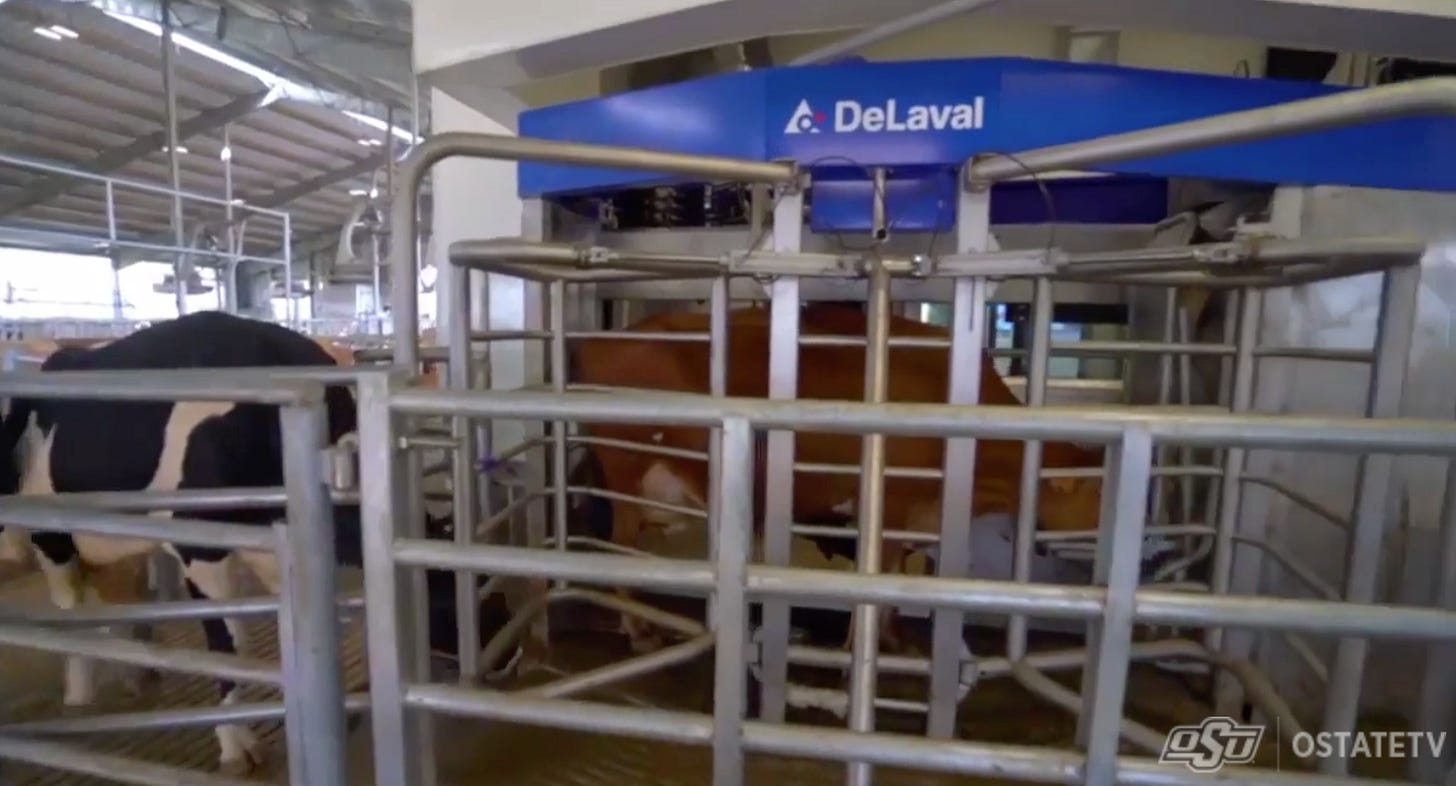University dairy installs robotic milking
Wildfires in California spark new cattle grazing website

Source: OStateTV webcastOSU dairy installs a DeLaval robot
A new public visitor center at the 100-cow Oklahoma State University Dairy that houses a new milking robot was unveiled this week. The farm now has one DeLaval robot but continues to milk the herd of Holsteins and Jerseys twice daily in a double-6 herringbone parlor. For now, the milking robot is a supplement to the farm’s conventional milking.
The new visitor center which houses the robot is located next to a state-of-the-art, sand-bedded freestall barn built two years ago. The updates at the farm are based on a donation of several million dollars by former president and CEO of Schreiber Foods Larry Furgeson and his wife, Kayleen. The Furgesons are alumni of Oklahoma State. They donated $2 million to the dairy in 2015 and have provided an additional $4 million dollars in matching funds for ongoing upgrades.
During the virtual grand opening, the university said the robot was installed at a “favorable price.” Both the Holsteins and Jerseys have “acclimated very well” to the new robot, which has been installed for several weeks now.
Ferguson said in a video message played during the event that there is “a lot of pent up capability in the U.S.” and he hopes the farm’s recent upgrades will inspire students and the dairy industry to want to continue to feed the world.
To see a tour of the dairy, go here at time marker 6:35.
Subscribe to The Cow Tech Report and don’t miss future updates:
Dairies tout their activity monitoring systems
Two large-herd dairies in the Midwest were featured this week in new videos talking about Allflex Livestock Intelligence’s activity monitoring systems.
Source: YouTubeMarty Burken of Blue Hyll Dairy in Clinton, Iowa, and Andy Buttles of Stone-Front Farm in Lancaster, Wisconsin, both talked about their systems in videos released this week on YouTube.
Burken says his goal is for all but three hours of the day (during milking) to be free for the cows to do as they chose. Since installing the system, he’s seen “drastic” changes in treatment costs, employee time in the barn, medicine orders and cows going off feed. He also uses a sort gate on his farm to draft cows that need further attention.
“I don’t want them stuck in headlocks for an hour,” Burken says.
Burken believes an automated sort gate can get the same amount of work done in finding cows as what “three employees can do.”
He’s seen increases in heat detection and service rates. Overall, preg rates are up 10 percent since using the system.
Buttles reports similar benefits on his 1,150-cow dairy.
“One thing when we were growing [the dairy] is that we didn’t want to lose touch of taking care of each cow. The system allows us to maintain attention to detail to the level like when we had only 100 cows,” he says.
He uses the company’s milk weights in addition to its activity monitors. He’s seen a decrease in death loss and antibiotic use.
“Advanced monitoring is definitely the future,” Buttles says.
Wildfires in California spark new cattle grazing website
Extension experts in California have partnered with colleagues in South Dakota to create MatchGraze.com. The map-based website is designed to help livestock owners find pasture, rangeland, cover crops or crop residue available for grazing and help landowners find cattle to graze their land.
The technology that drives the site was developed in 2015 as part of a producer-led, soil health initiative in South Dakota. The concept of the site as applied in the Golden State is seen as way to reduce the accumulation of fire fuels, helping to slow the spread of wildfires, of which there were many in California this past summer.
The website is not limited to use by those only in California and South Dakota. Users from anywhere in the U.S. can create accounts and advertise their land available for grazing or their livestock available to graze.
Learn more here.
CattleEye gets accelerated
The UK-based computer vision company CattleEye got accepted this week into a domestic artificial intelligence (AI) accelerator. The company was the only ag or cow tech company among the 32 accepted in the cohort. The accelerator helps support companies to scale up and “become the AI unicorns of the future.”
CattleEye is an autonomous livestock monitoring platform utilizing video analytics powered by deep-learning AI.
Read more about the accelerator here.

Profit projections from ZISK
Projected profitability for two dairy herd sizes INCREASED this week in the profit projections from ZISK.
ZISK is a profit-projection smartphone app that tracks individual dairy farm profitability based on current CME board prices. Projections for a 1,000-cow dairy producing an average of 80 pounds of milk per cow and a 2,500-cow dairy producing an average of 85 pounds of milk per cow are provided.
12-month dairy farm profit projections (as of Oct. 22, 2020):
1,000-cow dairy = $484,437 (UP $9,605 from last week)
2,500-cow dairy = $1.88 million (UP more than $40,000 from last week)
Source: Zisk


